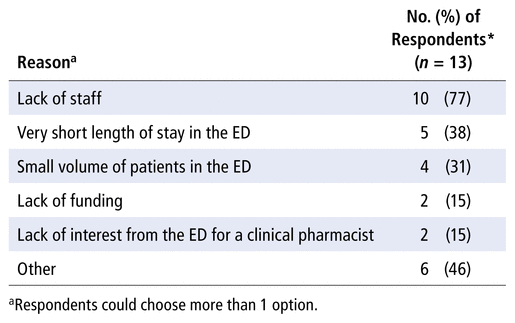
Jessica Doiron, Madeleine Genest, Julie Morin, Jean-François Patenaude-Monette, Pierre-Olivier Monast, Nathalie Marceau, Eric VilleneuveABSTRACT
Background
According to a Canadian survey conducted in 2013, 37 of the 67 Quebec emergency departments (EDs) in hospitals with more than 50 beds reported having a pharmacist within the department. However, based on the 17 responses to the survey, it was not possible to determine patient care services offered by Quebec ED pharmacists, because the data were aggregated across all Canadian respondents. A provincial survey was undertaken to further define ED pharmacy practice within Quebec.
Objectives
To measure pharmacist involvement in EDs in the province of Quebec and to describe patient care services and interventions offered by these pharmacists.
Methods
A 47-question survey was sent to 33 directors of pharmacy departments, representing 90 hospitals and institutes with EDs in the province of Quebec. The directors of pharmacy were asked to forward the survey to an ED pharmacist for completion or to partially answer the survey themselves if their facilities had no pharmacists practising in the ED. The survey evaluated the presence of pharmacists in the ED, their training, the interventions they performed, and their involvement within the department. The presence and role of ED pharmacy technical staff were also evaluated.
Results
Of the 43 completed surveys received, 30 reported at least 1 pharmacist providing patient care within the facility’s ED. The most common tasks performed by ED pharmacists were, in decreasing order of frequency, answering questions from the multidisciplinary team, adjusting medications according to patients’ allergies or their renal or hepatic function, managing drug interactions, and clarifying prescriptions. Pharmacists also reported teaching pharmacy students and residents and supporting the team in the resuscitation area.
Conclusions
The majority of respondents reported having at least 1 pharmacist in the ED. Compared with previous Canadian results, this survey had more respondents from Quebec with better representation of ED pharmacy practice in the province. Patient care services provided by pharmacists were variable, possibly because of a lack of standardized practice guidelines.
KEYWORDS: emergency, pharmacy, clinical services
RÉSUMÉ
Contexte
Selon une enquête canadienne menée en 2013, 37 des 67 services des urgences dans des hôpitaux québécois de plus de 50 lits ont déclaré avoir un pharmacien au sein de leur service. Cependant, à partir des 17 réponses de cette enquête, il n’a pas été possible de déterminer les services de soins aux patients offerts par les pharmaciens des services des urgences du Québec, car les données étaient agrégées pour tous les répondants canadiens. Une enquête provinciale a été menée pour mieux définir la pratique de la pharmacie au sein des services des urgences au Québec.
Objectifs
Mesurer l’implication des pharmaciens dans les services des urgences du Québec et décrire les services de soins aux patients et les interventions offerts par ces pharmaciens.
Méthodes
Un sondage comportant 47 questions a été envoyé à 33 chefs de départements de pharmacie, représentant 90 hôpitaux et instituts ayant un service des urgences au Québec. Les chefs de départements de pharmacie ont été invités à transmettre le sondage à un pharmacien du service des urgences pour qu’il y réponde; ou, si leur établissement ne comptait aucun pharmacien exerçant en service des urgences, à y répondre partiellement eux-mêmes. L’enquête a permis d’évaluer la présence des pharmaciens dans les services des urgences, leur formation, leurs interventions et leur implication au sein du département. La présence et le rôle du personnel technique en pharmacie des urgences ont également été évalués.
Résultats
Sur les 43 questionnaires remplis reçus, 30 indiquaient avoir au moins un pharmacien prodiguant des soins aux patients dans le service des urgences de l’établissement. Les tâches les plus courantes consistaient, par ordre décroissant de fréquence, à répondre aux questions de l’équipe multidisciplinaire, à adapter les médicaments selon les allergies des patients ou leur fonction rénale ou hépatique, à gérer les interactions médicamenteuses et à clarifier les ordonnances. Les pharmaciens ont également déclaré former les étudiants et les résidents en pharmacie et soutenir l’équipe dans la salle de réanimation.
Conclusions
La majorité des répondants ont déclaré avoir au moins un pharmacien au service des urgences. Par rapport aux résultats canadiens antérieurs, cette enquête comptait plus de répondants du Québec et indiquait une meilleure représentation de la pratique de la pharmacie au service des urgences dans la province. Les services de soins aux patients fournis par les pharmaciens étaient variables, peut-être en raison d’un manque de directives de pratique normalisées.
MOTS CLÉS: urgence, pharmacie, services cliniques
Previous research has shown that a pharmacist practising within the emergency department (ED) has a beneficial effect on patient outcomes in various clinical settings. For example, the presence of ED pharmacists is associated with reductions in medication errors and costs, as well as improvements in compliance with guidelines.1 More specifically, examples of ED pharmacists’ beneficial effects include reducing delays in administration of thrombolysis for stroke, of the first dose of antibiotics in sepsis, of analgesia in trauma, and of post-intubation analgesia.2–5 Furthermore, pharmacists’ involvement with the resuscitation team increases patient survival to hospital admission.6
Despite these proven benefits, the authors of a Canadian survey conducted in 2013 noted that only 37 (55%) of 67 Quebec hospitals with more than 50 acute care beds reported having a pharmacist practising within the ED, and only 17 of these 37 facilities responded to the survey.7 Furthermore, almost half (43%) of the pharmaceutical services within Canadian EDs had been implemented within the previous 4 years, an indication that pharmacy practice within Canada was growing.7 This national survey provided a general portrait of direct patient care services offered by Canadian ED pharmacists. The most commonly provided services were order clarification, troubleshooting, medication reconciliation, and assessment of renal dosing.7
To assess pharmacy practice within EDs in Quebec in greater detail, we conducted a survey of hospital pharmacy departments. The study objectives were to quantify the presence of pharmacists within EDs across Quebec and to describe the types of pharmaceutical services offered. More specifically, the survey sought information about the number of ED pharmacists employed, their training, types of pharmaceutical care activities offered, and involvement on resuscitation teams and in other activities, including teaching. We also aimed to identify the presence and roles of pharmacy technical staff within the ED. For departments without a pharmacy presence in the ED, we aimed to determine the main barriers to implementing this service.
A 47-question survey was developed by a group of 3 ED pharmacists (J.D., J.M., J-F.P.-M.) and was then reviewed and validated by peers and members of the Association des pharmaciens des établissements de santé du Québec (A.P.E.S.), the mandatory association representing all Quebec hospital pharmacists. The questions and overall themes included in the survey were based on previously published surveys on pharmacy practice in the ED.7,8 The full content of the survey is available upon request to the corresponding author. The survey was hosted on the SurveyGizmo platform (SurveyGizmo [now known as Alchemer]).
In January 2020, a link to the survey was sent to all directors of pharmacy of hospitals located in the province of Quebec through A.P.E.S. Reminders were sent 2 and 4 weeks before the survey deadline of February 18, 2020. The directors of pharmacy were asked to designate a pharmacist in charge of pharmacy activities in the ED to complete the questionnaire. This respondent had to answer for all of their colleagues and therefore had to have access to all data concerning pharmacists working in the ED (e.g., highest level of education, certifications, number of years working in the ED, percentage of time spent in the ED). If the facilities had no pharmacist practising in the ED, the director of pharmacy was asked to complete a shortened version of the survey. Participation in this study was voluntary, and no financial compensation was offered to participants. All answers were kept anonymous.
This study was approved by the McGill University Health Centre Research Ethics Board.
The invitation to participate in the survey was sent to 33 directors of pharmacy, representing 90 hospitals with EDs. The number of EDs was established through the annual report of La Presse (a French-language newspaper based in Montréal)9 and was then adjusted to also include 6 institutes and pediatric or psychiatric hospitals that were excluded from the annual report but that have operational EDs. Of the 43 respondents who completed the survey, 30 (70%) reported having at least 1 pharmacist practising in the ED. The most common explanations for the absence of ED pharmacists are presented in Table 1.
TABLE 1 Reasons for Lack of a Pharmacist in the Emergency Department (ED)

The period over which pharmacy services had been offered in the ED, as well as the number of hours per week that a pharmacist was dedicated to the ED, varied among respondents. Across the 30 EDs, pharmacists began performing patient care activities within the previous 1 to 5 years in 5 EDs (17%), 5 to 10 years ago in 6 EDs (20%), 11 to 20 years ago in 15 EDs (50%), and more than 20 years ago in 4 EDs (13%). Nineteen pharmacy departments (63%) assigned a pharmacist to work 33 to 40 h/week in the ED, and 5 (17%) allocated more than 40 pharmacist-hours weekly. In all cases, pharmacists were scheduled in the ED during weekday shifts, with 1 pharmacy department also offering coverage that overlapped with the evening shift. In addition to pharmacists, 17 (57%) of the 30 EDs had pharmacy technical staff assigned specifically to the ED.
Pharmacy technical staff assigned to the ED performed a variety of tasks. In 14 (82%) of the 17 EDs with designated pharmacy technical staff, these personnel performed tasks related to the medication-use system, such as dispensing, prescription entry, and stock management, including refilling medication cabinets. In 7 (41%) of these 17 EDs, pharmacy technical staff assisted with medication reconciliation.
Of the 30 respondents from facilities with pharmacists assigned to the ED, 21 were pharmacists actually practising within the ED, whereas the other 9 were pharmacists filling various management positions, who answered on behalf of pharmacists practising in the ED. Respondents reported a total of 129 pharmacists who practised in the ED. For most of these pharmacists (n = 110, 85%), the highest completed level of education was a Master of Science (MSc), which is the hospital pharmacy residency program in Quebec (Table 2). The most common complementary training was Advanced Cardiac Life Support (ACLS), completed by 26 ED pharmacists (20%). The American College of Clinical Pharmacy (ACCP) offers several board certifications. Although board certification for emergency medicine pharmacy is not available, ED pharmacists in Quebec had ACCP certifications in other areas, specifically critical care, pharmacotherapy, oncology, and geriatrics.
TABLE 2 Training and Experience of Emergency Department (ED) Pharmacists
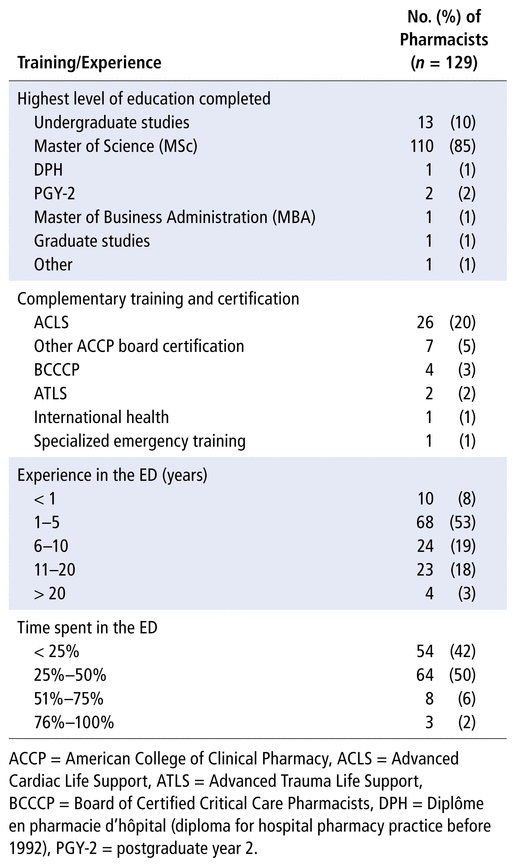
Of the 30 pharmacy departments providing pharmaceutical care in the ED, 5 (17%) reported having a decentralized pharmacy within the ED for order verification. Of these, 3 also dispensed medications directly from the satellite pharmacy. Including EDs with satellite pharmacies, 13 EDs (43%) had pharmacists performing order verification for some portion of their time; in the majority of these (9 of the 13), the pharmacists spent 20% or less of their time on this activity. Of note, 1 ED pharmacist allocated more than 80% of their time to verifying prescriptions. When asked if order verification by an ED pharmacist was of added value to the pharmaceutical care offered to patients, 18 (60%) respondents believed there was no added benefit.
The ED pharmacists performed a wide variety of tasks while providing direct patient care. The most common activities, in decreasing order of frequency, were answering questions from the multidisciplinary team, adjusting medications according to the patient’s allergies or their renal or hepatic function, managing drug interactions, clarifying drug prescriptions, evaluating adverse drug events, and taking part in activities in the resuscitation area (Table 3).
TABLE 3 Pharmaceutical Care Activities Performed
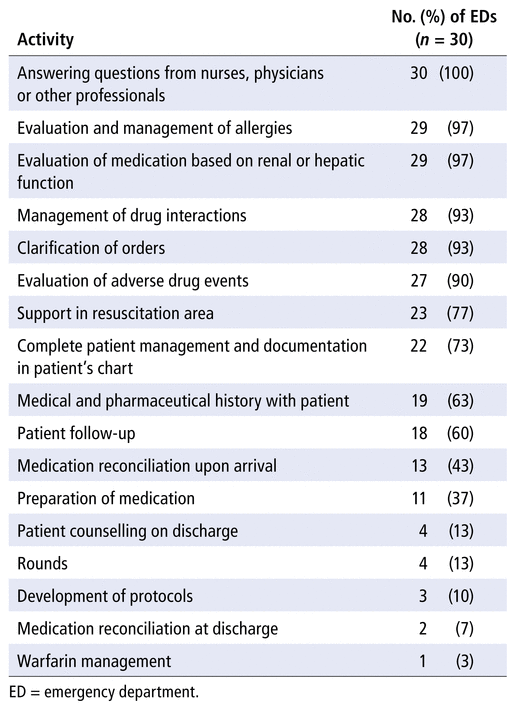
Most ED pharmacists (n = 22, 73%) reported having minimal involvement in the care of ambulatory care patients within the ED, typically seeing no more than 1 ambulatory patient per day.
As shown in Table 3, 23 (77%) of the 30 ED pharmacy teams offered support in the resuscitation area. More specifically, the most commonly performed tasks related to resuscitation, in decreasing order of importance, were answering medication-related questions, preparing medications, obtaining patients’ medication list and history, and taking part in therapeutic decision-making.
In addition to the support provided within the resuscitation area, 9 (30%) of the ED pharmacy teams were part of the hospital’s “code blue” team.
Given high patient turnover in the ED, pharmacists’ interventions may range from briefly intervening in a patient’s medication regimen through answering questions to performing a complete analysis and management of a patient’s pharmacotherapy. Most commonly, ED pharmacists performed 11 to 20 brief interventions (n = 13, 43%), answered 6 to 10 questions (n = 10, 33%) and performed complete pharmacotherapy management for 1 to 5 patients (n = 14, 47%) per day. “Brief interventions” are interventions targeted to a specific situation (e.g., clarifying an allergy, adjusting a dose, or modifying therapy because of an interaction) that are implemented without a complete review of the patient’s chart. The frequency with which such brief interventions were performed daily was highly variable (Table 4).
TABLE 4 Frequency of Pharmaceutical Activities during 8-Hour Shift in the Emergency Department (ED)
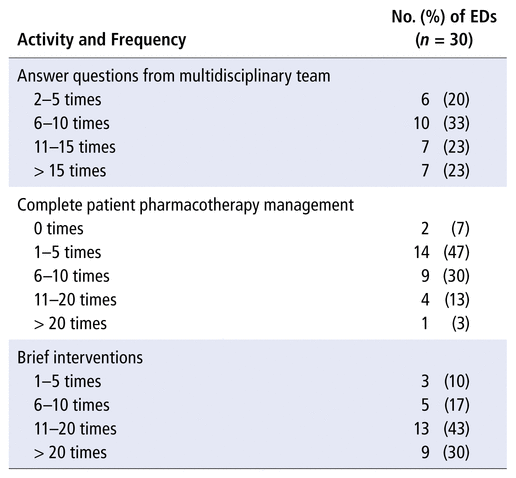
Respondents reported that their ED pharmacist provided pharmaceutical care to a median of 15 patients per day. Given that the daily number of patients visiting most Quebec EDs is greater than the number that can be seen by a single pharmacist in a day, 29 (97%) of the 30 ED pharmacists reported having to prioritize which patients they saw and which interventions they performed. The most commonly reported prioritization criteria were, in decreasing order of importance, patients with a medication-related problem detected by the pharmacist at the centralized pharmacy (25/29 [86%]), patients with a pharmacy consult requested by the medical team (25/29 [86%]), patients receiving care in the resuscitation area (18/29 [62%]), patients taking drugs with a narrow therapeutic index or taking high-risk medications (18/29 [62%]), and patients who were to be admitted to a ward (17/29 [59%]).
Survey respondents were asked to classify a prespecified set of interventions in order of importance according to actual practice and also according to how they believed these interventions should be prioritized. The difference in classification is presented in Table 5.
Table 5 Current and Desired Importance of Interventions
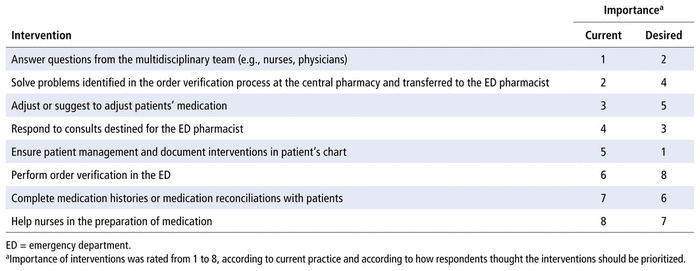
The standards of practice of the Ordre des pharmaciens du Québec specify that pharmacists’ interventions be documented in patient charts.10 However, this survey showed that the rate of documentation of ED pharmacists’ activities was variable: 4 respondents (13%) reported a documentation rate of 1%–10%, 5 (17%) reported a rate of 26%–50%, 8 (27%) reported a rate of 51%–75%, and 13 (43%) reported a rate of 75%–100%.
The provincial Pharmacy Act (https://www.legisquebec.gouv.qc.ca/en/document/cs/p-10) was amended in 2015 (Bill 41) to allow for an expansion of pharmacists’ scope of practice. Of the 30 survey respondents, 21 (70%) reported that their team of pharmacists performed activities allowed through this expansion of scope. Potential activities and their application are reported in Table 6.
TABLE 6 Activities Related to Bill 41 (2015)
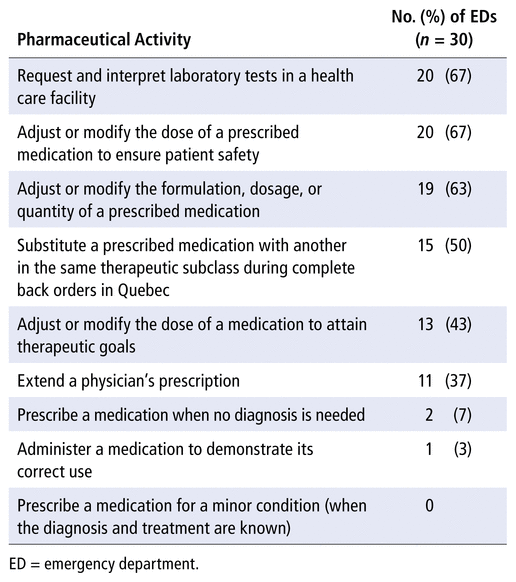
Pharmacy internships in the ED were offered by 27 (90%) of the 30 respondents. Among these 27 EDs, internships were offered to second-year entry-level PharmD students in 21 EDs (78%), to fourth-year entry-level PharmD students in 24 EDs (89%), and to pharmacy residents in 22 EDs (81%). Also, 11 (37%) of the 30 ED pharmacy teams had at least 1 member who taught at a university.
In addition to teaching and serving as preceptors within the pharmacy profession, 10 respondents (33%) reported that their team of pharmacists provided continuing education to other health care professionals within the ED team.
To the authors’ knowledge, this survey is the first to specifically describe current pharmacy practice in Quebec EDs. The presence of pharmacists within the ED seems to be growing, with 5 additional hospitals having developed the service within the past 5 years. This trend toward increased pharmacist presence in the ED has also been observed in the United States.11 Despite this development, approximately 30% of respondents to this survey still had no pharmacist presence within their ED. Of note, as reported in previous surveys,7,8 the percentage of departments with a pharmacist was proportional to the number of stretchers, whereby 100% of EDs with more than 40 stretchers had a pharmacist present in the department.
The main limitations to development of pharmaceutical care services in the ED in Quebec were different from those underlined in the Canadian survey,7 with a lack of pharmacists being one of the main limitations identified in our survey. The Canadian survey identified lack of training as a barrier to implementing this service,7 but lack of training was not a perceived issue for our respondents. Of the pharmacists providing ED services in our survey, 86% had a general hospital residency (MSc, the Quebec graduate degree diploma for hospital pharmacy practice, or, before 1992, DPH [Diplôme en pharmacie d’hôpital]). This proportion is higher than the 75% found in the 2013 Canadian survey.7 However, the majority of pharmacists in our study had 5 years or less experience within the ED. In terms of additional training, several pharmacists had complementary training in ED-specific fields, such as ACLS. Some also had training or certification in fields outside of the ED. This non-ED training may reflect the broad spectrum of pharmaceutical needs of patients in the ED or the previous or concurrent practices of these ED pharmacists, given that most of them spent no more than 50% of their time in the ED.
The exercise of prioritizing activities according to actual and desired practice showed some important differences. For example, ED pharmacists reported wanting to prioritize patients’ pharmacotherapy management and documentation of interventions in patient charts to a greater extent than in their current practice. Conversely, solving problems identified by and transferred from pharmacists in the central pharmacy, performing order verification, and making adjustments were being performed more often than what the ED pharmacists believed was necessary. The desired prioritization of these tasks was generally in line with current literature showing the added benefit of pharmacists in several ED clinical settings, such as resuscitation, trauma, stroke, and myocardial infarction. Being proactive in these specific settings allows the pharmacist to play an active role in preventing medication errors while providing medication information to the ED multidisciplinary team. The survey did not specifically ask whether pharmacists prioritized patients through manual screening or by using software integrating predetermined criteria.
The difference between tasks that pharmacists currently perform in the ED and those shown to have added benefit for patient care may reflect the evolution of ED pharmacy practice. For instance, the presence of a pharmacist within the resuscitation area in Quebec EDs was slightly higher than that reported in previous surveys, with 77% of respondents in the current provincial survey versus 61% in the 2013 Canadian survey.7 This evolution of practice may not have been shared with or may be misunderstood by other members of the ED team or by non-ED pharmacist colleagues. There are currently no standards of practice or guidelines establishing the activities that an ED pharmacist in Quebec should be performing, which was reflected in variability among respondents. Interpretation of the definition of an ED pharmacist can also be variable, with 1 respondent reporting that more than 80% of the ED pharmacist’s time was spent doing order verification. However, in 2021, the American Society of Health-System Pharmacists published guidelines on the practice of emergency medicine pharmacy services,11 which could guide pharmacy and ED teams in establishing a standardized pharmaceutical service to be offered while local guidelines are developed.
Our survey had some limitations. The response rate of 48% was in line with the response rates in previous reports but may have biased our results. The reported proportion of EDs with pharmacists may have been overestimated, with a possible response bias in favour of EDs that had pharmacists. Also, among the respondents who reported that their facilities had ED pharmacists, 30% were not themselves providing clinical services in the ED but rather were working as pharmacy managers. This may have affected the accuracy of responses compiled for some questions regarding hands-on practice if the manager did not complete the survey with direct input from ED pharmacists. The reason for this deviation from the survey protocol is unknown, but it might be explained by lack of clarity in the wording of the survey instructions. Finally, because the roles and interventions of pharmacists in different clinical settings have not yet been clearly defined, certain elements of practice could be left to the respondent’s interpretation, which may have led to confounding of some responses. For example, although most pharmacists can distinguish a brief intervention from a complete pharmacotherapy assessment, the exact components of each can vary, which may have influenced the volume of specific activities provided and reported in the survey.
The practice of pharmacy in Quebec EDs has evolved over recent years, with an increasing presence of pharmacists in this setting. However, their presence remains inconsistent because of a long-lasting shortage of hospital pharmacists in Quebec. The practice of ED pharmacists is also variable, possibly because of the lack of a standardized practice statement and differences in the training and experience of available staff. These results should help in the development of practice guidelines for Quebec emergency pharmacists and in the harmonization of pharmacist practice in the ED.
1 Campbell MJ, Wells E, Tietz D, Balmat R, Wesolek J, Mace SE, et al. Direct patient care activities and interventions of emergency medicine pharmacists. Int J Clin Pharm. 2019;41(3):667–71.
Crossref PubMed
2 Gilbert BW, Huffman, J. Effect on door-to-needle recombinant tissue plasminogen activator administration times for acute ischemic stroke with and without an emergency department pharmacist. J Am Coll Clin Pharm. 2019;2(6):628–32.
Crossref
3 Moussavi K, Nikitenko V. Pharmacist impact on time to antibiotic administration in patients with sepsis in an ED. Am J Emerg Med. 2016; 34(11):2117–21.
Crossref PubMed
4 Lamkin L, Lindsey S, Weant K, Shoff H, Pinkston C. Implications of the presence of an emergency medicine pharmacist during critical care trauma patient resuscitation. J Am Coll Clin Pharm. 2019;2(3):251–6.
Crossref
5 Robey-Gavin E, Abuakar L. Impact of clinical pharmacists on initiation of postintubation analgesia in the emergency department. J Emerg Med. 2016;50(2):308–14.
Crossref
6 McAllister MW, Chestnutt JG. Improved outcomes and cost savings associated with pharmacist presence in the emergency department. Hosp Pharm. 2017;52(6):433–7.
Crossref PubMed PMC
7 Wanbon R, Lyder C, Villeneuve E, Shalansky S, Manuel L, Harding M. Clinical pharmacy services in Canadian emergency departments: a national survey. Can J Hosp Pharm. 2015;68(3):191–201.
PubMed PMC
8 Thomas MC, Acquisto NM, Shirk MB, Patanwala AE. A national survey of emergency pharmacy practice in the United States. Am J Health Syst Pharm. 2016;73(6):386–94.
Crossref PubMed
9 Lacoursière A. Quatorzième palmarès des urgences: tableau et carte interactive. La Presse; 2019 [cited 2022 Feb 9]. Available from: https://www.lapresse.ca/multimedias/palmares-des-urgences-2019
10 Standards de pratique. Ordre des pharmaciens du Québec, Direction des services professionnelles, Direction des communications; 2016 [cited 2021 Oct 3]. Available from: https://www.opq.org/wp-content/uploads/wooccm_uploads/290_38_fr-ca_0_standards_pratique_vf-min.pdf
11 Ortmann MJ, Johnson EG, Jarrell DH, Bilhimer M, Hayes BD, Mishler A, et al. ASHP guidelines on emergency medicine pharmacist services. Am J Health Syst Pharm. 2021;78(3):261–75.
Crossref PubMed
Competing interests: For activities unrelated to the study reported here, Julie Morin has served as copresident of the nonprofit organization Pharmacists Without Borders Canada (without remuneration) and sits on its board of directors, and Pierre-Olivier Monast has received honoraria from the Université de Montréal. No other competing interests were declared. ( Return to Text )
Funding: This study was supported by the Association des pharmaciens des établissements du Québec (A.P.E.S.). ( Return to Text )
Canadian Journal of Hospital Pharmacy, VOLUME 76, NUMBER 1, Winter 2023